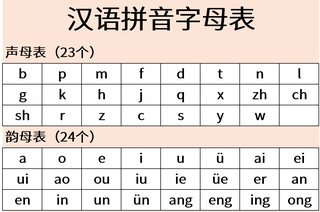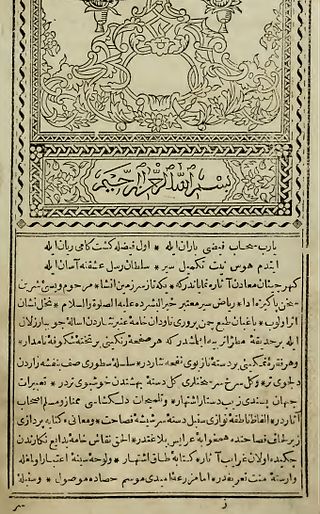
The Arabic alphabet, or Arabic abjad, is the Arabic script as it is codified for writing Arabic. It is written from right to left in a cursive style and includes 28 letters. Most letters have contextual letterforms.

Camel case is the practice of writing phrases without spaces or punctuation. The format indicates the separation of words with a single capitalized letter, and the first word starting with either case. Common examples include "iPhone" and "eBay". It is also sometimes used in online usernames such as "johnSmith", and to make multi-word domain names more legible, for example in promoting "EasyWidgetCompany.com".

Hanyu Pinyin, often shortened to just pinyin, is the official romanization system for Standard Mandarin Chinese in China, and to some extent, in Singapore and Malaysia. It is often used to teach Mandarin, normally written in Chinese form, to learners already familiar with the Latin alphabet. The system includes four diacritics denoting tones, but pinyin without tone marks is used to spell Chinese names and words in languages written in the Latin script, and is also used in certain computer input methods to enter Chinese characters. The word Hànyǔ literally means "Han language", while Pīnyīn (拼音) means "spelled sounds".
A syllable is a unit of organization for a sequence of speech sounds typically made up of a syllable nucleus with optional initial and final margins. Syllables are often considered the phonological "building blocks" of words. They can influence the rhythm of a language, its prosody, its poetic metre and its stress patterns. Speech can usually be divided up into a whole number of syllables: for example, the word ignite is made of two syllables: ig and nite.
The Burmese alphabet is an abugida used for writing Burmese. It is ultimately adapted from a Brahmic script, either the Kadamba or Pallava alphabet of South India. The Burmese alphabet is also used for the liturgical languages of Pali and Sanskrit. In recent decades, other, related alphabets, such as Shan and modern Mon, have been restructured according to the standard of the Burmese alphabet
Historical Chinese phonology deals with reconstructing the sounds of Chinese from the past. As Chinese is written with logographic characters, not alphabetic or syllabary, the methods employed in Historical Chinese phonology differ considerably from those employed in, for example, Indo-European linguistics; reconstruction is more difficult because, unlike Indo-European languages, no phonetic spellings were used.
Khmer script is an abugida (alphasyllabary) script used to write the Khmer language, the official language of Cambodia. It is also used to write Pali in the Buddhist liturgy of Cambodia and Thailand.
Pe is the seventeenth letter of the Semitic abjads, including Phoenician Pē , Hebrew Pē פ, Aramaic Pē , Syriac Pē ܦ, and Arabic Fāʼ ف.

The Persian alphabet is a writing system used for the Persian language spoken in Iran and Afghanistan since the 7th century after the Muslim conquest of Persia.

The writing system of the Korean language is a syllabic alphabet of character parts organized into character blocks representing syllables. The character parts cannot be written from left to right on the computer, as in many Western languages. Every possible syllable in Korean would have to be rendered as syllable blocks by a font, or each character part would have to be encoded separately. Unicode has both options; the character parts ㅎ (h) and ㅏ (a), and the combined syllable 하 (ha), are encoded.
General Chinese is a diaphonemic orthography invented by Yuen Ren Chao to represent the pronunciations of all major varieties of Chinese simultaneously. It is "the most complete genuine Chinese diasystem yet published". It can also be used for the Korean, Japanese, and Vietnamese pronunciations of Chinese characters, and challenges the claim that Chinese characters are required for interdialectal communication in written Chinese.
The Myanmar Language Commission Transcription System (1980), also known as the MLC Transcription System (MLCTS), is a transliteration system for rendering Burmese in the Latin alphabet. It is loosely based on the common system for romanization of Pali, has some similarities to the ALA-LC romanization and was devised by the Myanmar Language Commission. The system is used in many linguistic publications regarding Burmese and is used in MLC publications as the primary form of romanization of Burmese.
Iran System encoding was an 8-bit character encoding scheme and was created by Iran System corporation for Persian language support. This encoding was in use in Iran in DOS-based programs and after the introduction of Microsoft code page 1256 this encoding became obsolete. However, some Windows and DOS programs using this encoding are still in use and some Windows fonts with this encoding exist. Now most programs use code page 1256 or Unicode.

Rasm is an Arabic writing script often used in the early centuries of Classical Arabic literature. Essentially it is the same as today's Arabic script except for the big difference that the Arabic diacritics are omitted. These diacritics include i'jam, consonant pointing, and tashkil, supplementary diacritics. The latter include the ḥarakāt (حَرَكَات) short vowel marks—singular: ḥarakah (حَرَكَة). As an example, in rasm, the five distinct letters ـبـ ـتـ ـثـ ـنـ ـيـ are indistinguishable because all the dots are omitted. Rasm is also known as Arabic skeleton script.

The Ottoman Turkish alphabet is a version of the Arabic script used to write Ottoman Turkish until 1928, when it was replaced by the Latin-based modern Turkish alphabet.

The Lepcha script, or Róng script, is an abugida used by the Lepcha people to write the Lepcha language. Unusually for an abugida, syllable-final consonants are written as diacritics.
The classical or traditional Mongolian script, also known as the Hudum Mongol bichig, was the first writing system created specifically for the Mongolian language, and was the most widespread until the introduction of Cyrillic in 1946. It is traditionally written in vertical lines Top-Down, right across the page. Derived from the Old Uyghur alphabet, Mongolian is a true alphabet, with separate letters for consonants and vowels. The Mongolian script has been adapted to write languages such as Oirat and Manchu. Alphabets based on this classical vertical script are used in Mongolia and Inner Mongolia to this day to write Mongolian, Xibe and, experimentally, Evenki.

Hamza is a letter in the Arabic alphabet, representing the glottal stop. Hamza is not one of the 28 "full" letters and owes its existence to historical inconsistencies in the standard writing system. It is derived from the Arabic letter ʿAyn. In the Phoenician and Aramaic alphabets, from which the Arabic alphabet is descended, the glottal stop was expressed by alif (𐤀), continued by Alif in the Arabic alphabet. However, Alif was used to express both a glottal stop and also a long vowel. In order to indicate that a glottal stop is used, and not a mere vowel, it was added to Alif diacritically. In modern orthography, hamza may also appear on the line, under certain circumstances as though it were a full letter, independent of an Alif.
Although Old Chinese is known from written records beginning around 1200 BC, the logographic script provides much more indirect and partial information about the pronunciation of the language than alphabetic systems used elsewhere. Several authors have produced reconstructions of Old Chinese phonology, beginning with the Swedish sinologist Bernard Karlgren in the 1940s and continuing to the present day. The method introduced by Karlgren is unique, comparing categories implied by ancient rhyming practice and the structure of Chinese characters with descriptions in medieval rhyme dictionaries, though more recent approaches have also incorporated other kinds of evidence.

The Korean alphabet, known as Hangul in South Korea and Chosŏn'gŭl in North Korea, is the modern official writing system for the Korean language. The letters for the five basic consonants reflect the shape of the speech organs used to pronounce them, and they are systematically modified to indicate phonetic features; similarly, the vowel letters are systematically modified for related sounds, making Hangul a featural writing system. It has been described as a syllabic alphabet as it combines the features of alphabetic and syllabic writing systems, although it is not necessarily an abugida.









